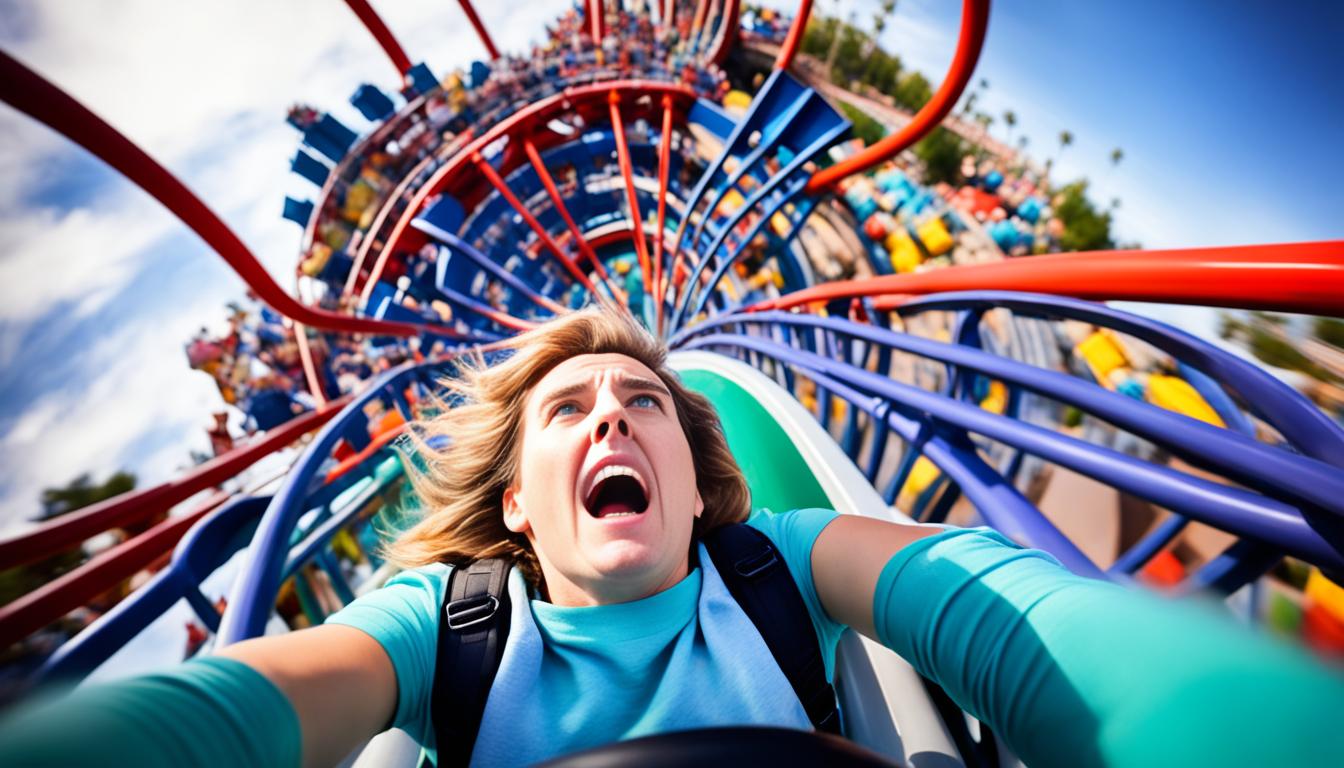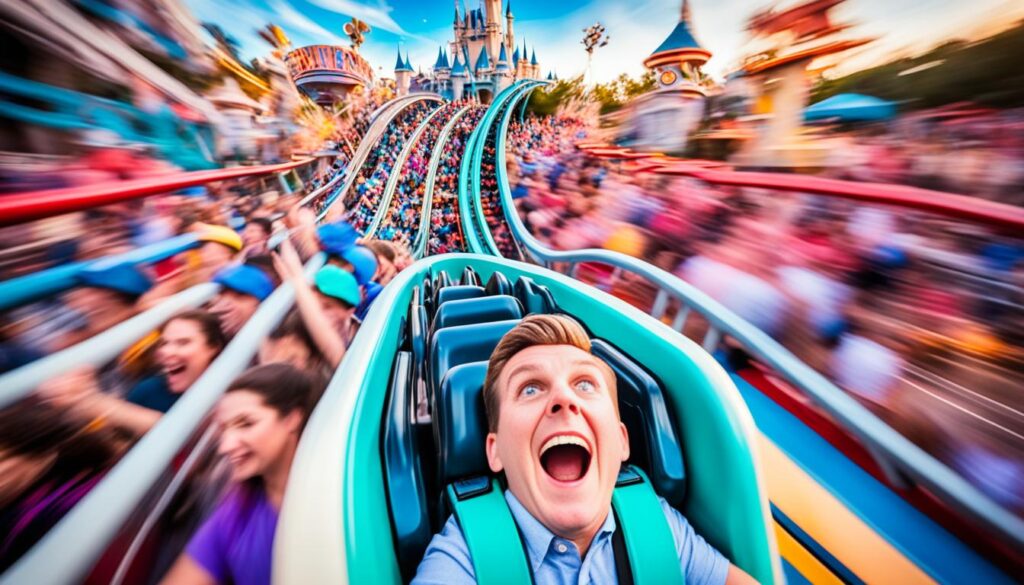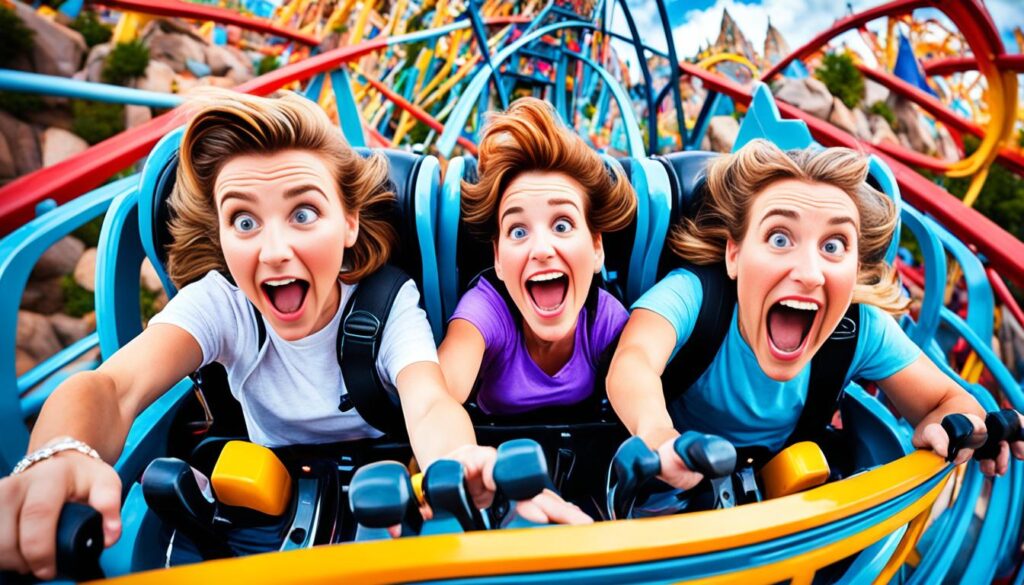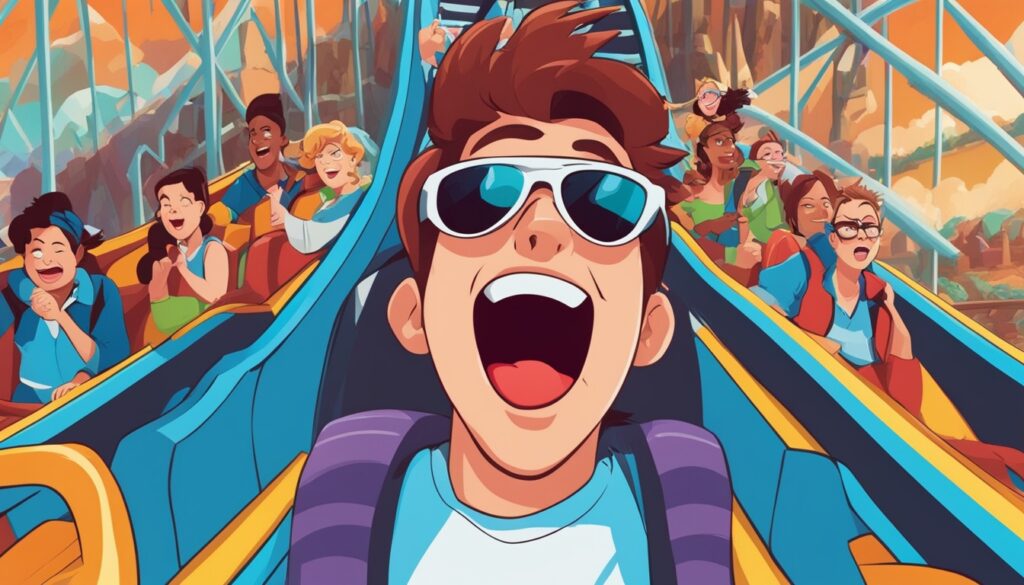Roller coasters offer a thrilling ride for millions every year. The sudden twists, turns, and drops can be both exciting and joyous. But, are these rides also a cause for headaches?
For some, yes, riding roller coasters can lead to headaches. The strong forces and sudden moves on a roller coaster can stress your body. For some, this stress ends up causing headaches or even migraines.
The way roller coasters move can bring on these headaches. The quick changes in speed, the sharp turns, and twists can shake your head and neck. This shaking might lead to headaches for those who are more sensitive.
At Disney World, some rides are known to potentially cause headaches. Space Mountain and Rock ‘n’ Roller Coaster are fast and intense, which might lead to head pains. Rides that spin, such as Mad Tea Party and Astro Orbiter, can also be headache triggers. Even rides with 3-D effects, like Star Tours and Avatar Flight of Passage, could play a part. The fast, sudden movements on The Twilight Zone Tower of Terror and Expedition Everest are also on the list.
These headaches can be influenced by many things. Stress, poor diet, not enough sleep, or suddenly stopping caffeine can all be contributors as well. It’s essential to recognize these triggers. This way, you can decide wisely and take precautions when stepping on a roller coaster.
Key Takeaways:
- Roller coasters can cause headaches for certain individuals due to the intense movement and forces.
- Rides with spinning motions, 3-D effects, and sudden drops may increase the likelihood of headaches.
- Factors such as stress, diet, caffeine withdrawal, and lack of sleep can also contribute to roller coaster-related headaches.
- Understanding potential triggers and taking necessary precautions can help individuals minimize the risk of experiencing headaches after riding roller coasters.
- If you experience concerning symptoms after riding a roller coaster, it is advised to monitor your symptoms and consult with a medical professional if they persist.
The impact of roller coasters on the brain
When you ride roller coasters, your brain moves a lot in your head. This can sometimes hurt the nerves and blood vessels in your brain. It might cause headaches or, rarely strokes.
Crowded places like Disney World can make it worse. That’s because being very hot or dehydrated can make these problems more serious.
Roller coasters are fast and make sharp turns. The forces they create can stress our brains. This might lead to headaches or make the fluid around our brain unbalanced.
Studies show that riding roller coasters can change our brain. For example, one study found that some people got worse headaches after rides. They also found that a few people were leaking fluid from their brain.
Another study from 2017 compared roller coasters to sports. They found that the roller coasters put as much stress on the brain as doing light sports. This stress can cause headaches.
Roller coaster injuries are not common. Scientists are still learning about how roller coasters affect our brains.
Roller coasters can be different in how intense they are. Some people might feel these effects on their brain more. If you have certain health issues, like aneurysms, you might be at higher risk.
In very rare cases, roller coasters have led to serious health problems or even death. It’s important to be informed about the risks before riding.
If you keep getting headaches after riding roller coasters, see a doctor. This is especially true if usual pain relief doesn’t help or the pain gets worse. Watch out for symptoms like blacking out or feeling dizzy. These could be signs of bigger problems.
The Importance of Safety Measures
Because of the risks to our brains, safety on roller coasters is very important. These rides can cause a lot of force on our brains. Talks are happening about how to make them safer and warn riders better.
Amusement parks should do things like check their rides often and give clear rules to riders. It’s also on the riders to look after themselves. This includes staying well-hydrated during hot times at parks.
Roller coasters are exciting but we need to think about our health too. Knowing how roller coasters can affect our brains and taking care can help us have fun more safely.
Signs and symptoms of roller coaster-related headaches
After you ride a roller coaster, keep an eye out for headaches. The excitement can trigger discomforts like headaches. You might feel a pain that throbs at the side or front of your head. Other signs could be feeling sick, being sensitive to light or noise, or seeming overstimulated.
If any of these headaches follow your ride, there are things you can do. Roller coaster headaches should go away on their own but you can try some remedies. Drink lots of water. Make sure you rest and relax. You could also take some pain relievers like acetaminophen or ibuprofen.
Just a reminder, the tips mentioned are general and can work differently for each person. It’s smart to talk to a doctor. They can give advice that suits you best.
Also, it’s good to know what to avoid. This can make sure your headache doesn’t get worse or stay longer. Stay away from too much alcohol. Make sure you eat and don’t pull all-nighters. Avoid looking at screens for too long.
But if your headaches keep getting worse, see a doctor. It’s the safest thing for your health. Always make sure to put your health first.
Roller coasters and concussions
Roller coasters are a favorite among thrill-seekers and attract millions yearly. But with the fun comes potential danger, especially when it comes to head injuries.
A 2017 study found that riding roller coasters could impact the brain like sports collisions. The rapid forces could lead to head traumas and concussions.
High school students face these risks more than others. In 2017, 2.5 million of them got concussions from sports or fun activities. An alarming 1 million suffered two or more concussions in just one year.
Safety is paramount while riding roller coasters. Wear a helmet to cut down the chance of a concussion. Enjoy the thrill but stay safe.
Disney World’s attractions, like Rock ‘n’ Roller Coaster and Big Thunder Mountain Railroad, may lead to headaches. So can Magic Kingdom’s Space Mountain and EPCOT’s Mission: SPACE.
Concussions can severely impact a person’s health. Symptoms might last for months or even longer. Whiplash from coasters can also cause neck injuries.
After a head injury at an amusement park, seek medical help. This ensures the right treatment and a smooth recovery. Options could include acupuncture or deep tissue massages.
Those with concussions might need to change their daily habits to get better. Avoiding screens, loud noises, and bright lights can help. Take breaks often to rest.
Roller coasters offer excitement but also risk. Maintaining safety and taking precautions can reduce injury chances. This way, everyone can have fun safely.
Dizziness and roller coaster rides
Dizziness often follows a thrilling roller coaster ride. The quick movements and strong g-forces are mostly to blame. This feeling is worse for those with chronic migraines. They should think twice before hopping on a roller coaster.
Keeping hydrated and well-rested can lessen post-ride dizziness. Also, taking pauses between intense rides helps. If you feel dizzy, your body’s telling you to slow down. Listening to these signals is key.
Some find relief by shutting their eyes or focusing on the ride’s direction. Others need a short break to let their body adjust. It’s all about finding what helps you feel better.
The link between chronic migraines and roller coaster-induced dizziness
People with chronic migraines might not enjoy roller coasters. Their condition can mix badly with the thrill of the rides. Those who suffer from migraines often find roller coaster dizziness worsens their migraine symptoms.
Studies show that the intense motions of roller coasters can be a migraine trigger. These motions, combined with the brain’s response to sudden g-forces, create a recipe for migraine mayhem. It’s wise for those prone to migraines to be careful. Safety first is not just a saying here.
“Living with migraines means I have to be careful with roller coasters. They can really set off my symptoms, making me dizzy and sick. I drink lots of water and take it easy between rides.”
– Sarah, roller coaster enthusiast
However, our bodies react differently. For some, dizziness is a quick, mild effect. For others, it can be severe. Always remember, if your dizziness is severe, it’s best to talk to a doctor. This is especially true if you have chronic migraines.
In conclusion, knowing your limits and how to manage them is key. Whether at Disney World or another park, staying alert to your body’s needs allows for a better experience. Have fun, but always be mindful of how rides affect you.
Roller coasters and motion sickness
Riding roller coasters at theme parks can be lots of fun. But, some people find they get motion sickness. This happens when the brain gets mixed signals from the body’s senses. Symptoms can include feeling sick, sweating a lot, and even throwing up.
At Walt Disney World, some rides might make you feel sick. For instance, DINOSAUR and Test Track can have you moving in jerky ways. This can add to your chance of getting motion sickness.
Spinning rides like Alien Swirling Saucers can make your head spin. This, too, might lead to motion sickness. Also, rides that make you feel like you’re falling, like Splash Mountain, could have the same effect.
When what you see doesn’t match how you feel, you might also get motion sick. 3D screens, as with Canada Far and Wide and Mickey’s Philharmagic, can trigger this problem.
Some rides are more likely to make you feel sick at Disney World. These include Mad Tea Party and Rock ‘n Roller Coaster. If you’re worried, close your eyes during the ride. This might help.
There are things you can do to help with motion sickness. Taking motion sickness pills, like Meclizine Hydrochloride, might work. So can using ginger or antacids. You can also try Seabands. They help some people feel better. Remember not to move your head and drink a lot of water.
If you get really sick, Disney has places to help. They have first aid areas with nurses. They can take care of you if you feel very bad from motion sickness.
Plan ahead for your trip to Walt Disney World if you’re worried about getting motion sick. Learn about the rides that might make you feel unwell. Practicing certain habits, like looking forward or closing your eyes, can help. This way, you can have a great time at Disney without getting motion sickness.
The link between migraines and roller coaster rides
People with migraines might get extra headaches after they ride roller coasters. Studies show their brains get extra active in certain spots during virtual roller coaster rides. This can make them more likely to feel sick and get more migraines.
If you have migraines, it’s good to know about this. You can then be careful when you think about going on roller coasters. This knowledge can help you avoid bad headaches and feeling sick.
Many folks love roller coasters, but it’s key to think about your health first. For those with migraines, this is even more important. You should try to lower the chance of getting a migraine when you ride.
Here are some headache prevention tips for individuals with migraines who plan to ride roller coasters at Disney World:
- Stay hydrated: Drink plenty of water before, during, and after the roller coaster ride to prevent dehydration, which can contribute to headaches.
- Take breaks: Pace yourself and take breaks between rides to give your body a chance to rest and recover.
- Choose milder rides: Opt for roller coasters with gentler movements and less intense forces to minimize the likelihood of triggering a migraine.
- Avoid triggers: Be mindful of factors that may exacerbate migraine symptoms, such as excessive heat, bright lights, loud noises, and certain scents.
- Consider medication: If recommended by a healthcare professional, take migraine prevention medication prior to riding roller coasters to reduce the risk of developing a headache.
With a few simple steps, those with migraines can have fun at Disney World. They can ride roller coasters with less worry about bad headaches.
Roller coaster safety and precautions
Roller coasters at Walt Disney World are thrilling for many each year. They bring fun but safety should come first. Here are some tips for a safe and fun roller coaster visit.
Follow Ride Safety Guidelines
Walt Disney World has strict rules for roller coasters to keep you safe. Always check the warnings and listen to the ride operators. If you break the rules, you might get hurt.
Wear Appropriate Head Protection
Wearing the right head protection is key to avoiding headaches and injuries. Roller coasters have helmets or head straps for a reason. Make sure they are on tight to protect your head.
Stay Hydrated
Don’t forget to drink water when riding roller coasters. Dehydration in hot places like Disney World can cause headaches. Bring your own water bottle to save money on drinks.
Consider Pre-Existing Conditions
If you have health issues like migraines, be careful on roller coasters. Ask a doctor if it’s safe for you to ride. Your health is more important than the thrill.
Report Safety Concerns
At Disney World or any park, safety is the top concern. Tell a staff member right away if you see something unsafe. This keeps everyone safe.
Stick to the safety advice and have a great time on roller coasters. Always think of your health first. Talk to a doctor if you’re unsure about riding.
Conclusion and final thoughts
Roller coasters at Disney World are full of thrills, but they come with some risks. Few people get headaches or migraines from riding them. Yet, these symptoms may affect some people more, because of the ride’s movements.
If you’re worried about headaches or you have a history of migraines, you can do a few things to stay safe. Make sure to drink enough water and get good sleep. It can also help to take medicine for the pain. Following the rules of the rides and wearing the right headgear is crucial to avoid injuries.
Disney World tries hard to keep costs down and handle the crowds. Yet, the number of people and the time you spend waiting can affect your visit. With the park always improving and prices going up, planning and budgeting for your trip is key.
Knowing how roller coasters link to headaches is vital. By taking these steps, you can enjoy rides at Disney World while keeping yourself safe.




